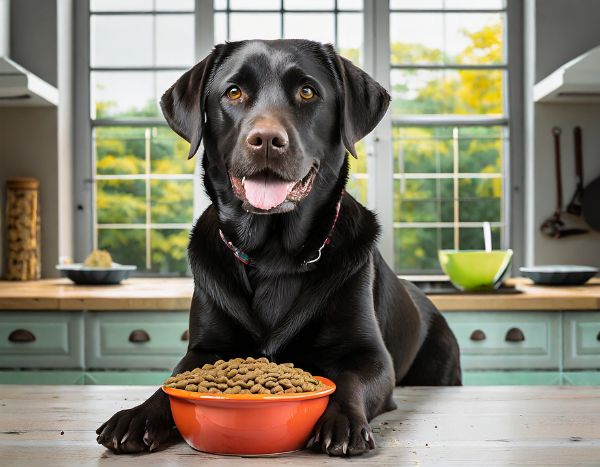Welcome to the world of grain-free dog food, a choice that many pet owners are embracing for the health and happiness of their furry friends. But what exactly does grain-free mean, and why might it be a good option for your pup? In this article, we’re diving deep into the realm of grain-free dog food, exploring the benefits, addressing common concerns, and even sharing some scrumptious recipes that you can whip up at home. So, buckle up and get ready to learn everything you need to know about grain-free diets for dogs!
Popular Grain-Free Recipes for Your Pooch
Transitioning to a grain-free diet for your dog can be a wonderful way to cater to their health needs, especially if they have grain sensitivities. Here are two popular grain-free recipes that are not only delicious but also packed with nutritional benefits to keep your dog healthy and happy.
Recipe 1: Savory Meat and Veggie Medley
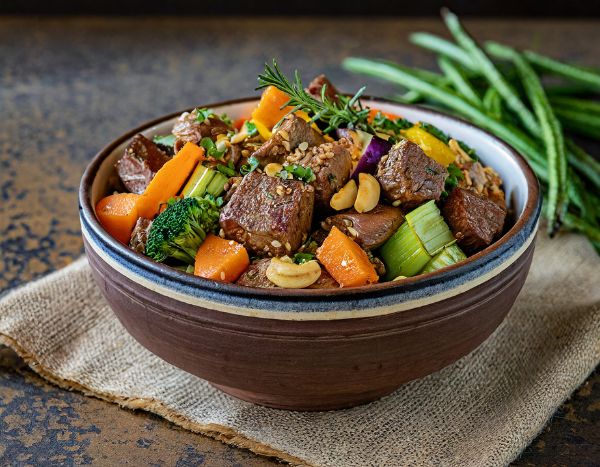
Ingredients:
- 1 pound lean ground beef
- 2 medium carrots, diced
- 1 cup peas, fresh or frozen
- 1 large sweet potato, cubed
Instructions:
- In a large skillet, cook the ground beef over medium heat until browned. Drain any excess fat.
- While the beef cooks, steam the carrots, peas, and sweet potatoes until tender. This can be done in a steamer basket over boiling water or in the microwave.
- Allow the cooked ingredients to cool, then combine them in a large bowl, mixing thoroughly.
- Serve up this hearty mix to your eager pup and watch them enjoy every bite!
Nutritional Benefits: This Meat and Veggie Medley is a powerhouse of nutrition. Lean ground beef provides high-quality protein, essential for muscle maintenance and repair. Carrots and sweet potatoes are excellent sources of beta-carotene, fiber, and other vitamins, supporting vision and digestive health. Peas add an extra punch of protein and fiber, along with a variety of minerals.
Recipe 2: Fish Delight for a Shiny Coat
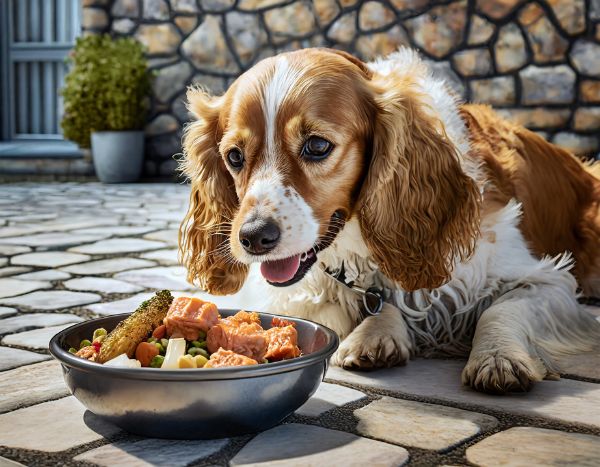
Ingredients:
- 2 fillets of salmon (skin removed)
- 1 cup spinach, finely chopped
- 1 medium zucchini, sliced
Instructions:
- Preheat your oven to 375°F (190°C). Place the salmon fillets on a baking sheet lined with parchment paper and bake for 20 minutes or until cooked through.
- In a pan, lightly sauté the spinach and zucchini until they’re just wilted and tender.
- Let the salmon and vegetables cool down before chopping the salmon into bite-sized pieces and mixing all the ingredients together.
- Serve this omega-rich feast to your four-legged friend for a meal that’s as tasty as it is nutritious.
Omega-3 Benefits: Salmon is a fantastic source of Omega-3 fatty acids, which are crucial for maintaining a dog’s healthy coat and skin. These fatty acids also support cognitive function and joint health. Spinach and zucchini are low in calories and high in vitamins and minerals, making them perfect for a balanced, grain-free meal.
Remember to consult with your vet before introducing new foods into your dog’s diet, especially if they have specific health conditions or dietary needs. These recipes are a guide to help you start your journey into homemade, grain-free dog food. Enjoy the process of creating these meals and the joy they bring to your pup’s mealtime!
Understanding Grain-Free Diets for Dogs
In the world of canine nutrition, grain-free diets have become a popular choice for pet parents looking to optimize their dog’s health. But what exactly does “grain-free” mean, and what are the potential benefits of this diet? Let’s dig into the details.
What Does Grain-Free Mean?
Grain-free dog food is formulated without the inclusion of common grains like wheat, corn, rice, barley, oats, or soy. These traditional carbohydrate sources are replaced with alternative ingredients to provide the necessary energy and nutrients.
Common Ingredients in Grain-Free Dog Food
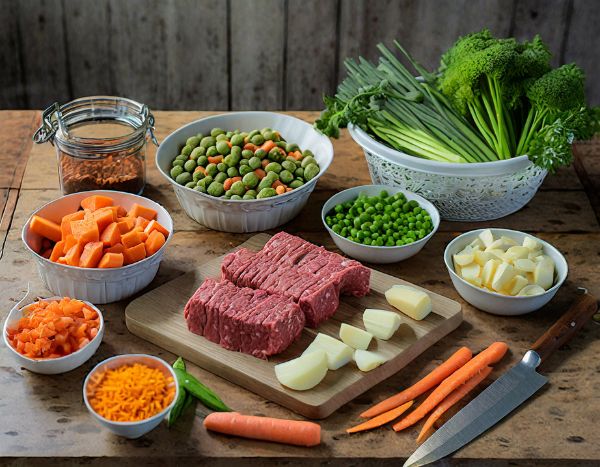
When grains are off the menu, what takes their place? Here’s a look at some typical components of a grain-free dog food:
- Proteins: High-quality proteins such as chicken, beef, fish, and eggs are the cornerstones of grain-free dog foods, supporting muscle development and repair.
- Vegetables: Nutrient-dense veggies like sweet potatoes, peas, and carrots often replace grains as a source of fiber and essential vitamins.
- Fruits: Some grain-free formulas incorporate fruits like apples or berries, which add antioxidants and additional nutrients to your dog’s bowl.
Potential Benefits of a Grain-Free Diet
Switching to a grain-free diet can have several advantages, particularly for dogs with specific dietary sensitivities:
- Allergy Relief: For dogs allergic to grains, a grain-free diet can be a game-changer, potentially reducing skin irritations and gastrointestinal upset.
- Improved Digestion: Dogs with sensitive stomachs may find grain-free foods easier to digest, leading to better nutrient absorption and stool quality.
- Higher Energy Levels: With a focus on high-quality proteins, grain-free diets can boost energy, which is especially beneficial for active and working breeds.
While the potential benefits of a grain-free diet can be appealing, it’s crucial to make an informed decision. For an in-depth look at grain-free diets and some of the considerations to keep in mind, the American Kennel Club offers a comprehensive guide that details the FDA’s findings on this dietary trend. You can read more about it in their article, “FDA Grain-Free Diet Alert: What Dog Owners Need to Know”.
It’s important to note that while a grain-free diet can be beneficial for some dogs, it’s not the right choice for every pet. Always consult with your veterinarian to determine the best dietary plan for your furry friend, taking into account their unique health needs and lifestyle.
When to Choose a Grain-Free Diet for Your Dog
Navigating the vast sea of dog food options can be daunting, especially when considering a grain-free diet. Let’s explore the scenarios where a grain-free diet might be the right choice for your canine companion.
Health Conditions That Might Benefit from a Grain-Free Diet
Certain health issues in dogs may improve with a grain-free diet. Here are a couple of conditions where pet owners have noticed benefits:
- Skin Allergies: If your dog is constantly itching or suffering from skin irritations, a grain-free diet could help alleviate these allergy symptoms.
- Digestive Issues: Dogs with a sensitive gastrointestinal tract might find relief with grain-free foods, which can be easier to digest and gentler on the stomach.
The Importance of Veterinary Guidance
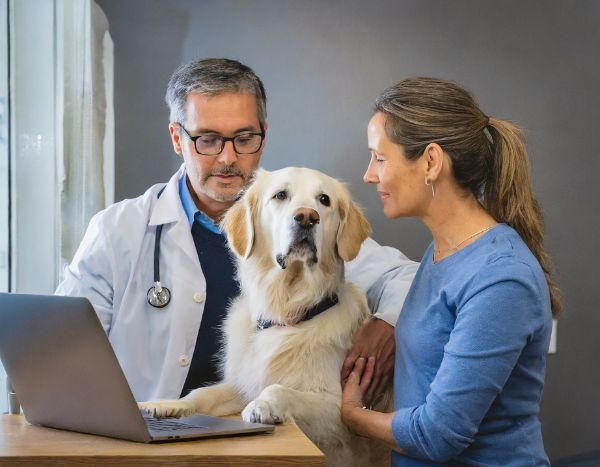
While anecdotal evidence and personal testimonials can be compelling, it’s essential to base your dog’s diet on professional advice.
- Consult a Vet: Always seek the guidance of a veterinarian before switching your dog to a grain-free diet. They can provide valuable insights into whether this diet is appropriate for your dog’s specific health needs and overall well-being.
Remember, each dog is unique, and what works for one may not work for another. A vet can help you navigate this decision, considering your dog’s health history, breed, age, and activity level to make an informed choice about their nutrition.
Tips for Transitioning to a Grain-Free Diet
Switching your dog to a grain-free diet isn’t something you should rush. Here’s a gentle approach to ensure a smooth transition for your furry friend.
Step-by-Step Guide to a Grain-Free Transition
A sudden change in diet can upset your dog’s stomach, so it’s important to take it slow.
- Gradual Change: Begin the transition by incorporating a small amount of grain-free food into their existing diet. Over the next week or two, gradually increase the grain-free portion while decreasing the old food until the switch is complete.
Signs to Watch For During the Transition
As you navigate this dietary shift, keep a close eye on your dog’s response.
- Positive Reactions: Ideally, you’ll see some good changes, such as a boost in energy or a reduction in allergy symptoms, indicating that the new diet is a good fit for your dog.
- Negative Reactions: Watch out for signs of digestive distress, such as diarrhea or vomiting. If you observe any adverse reactions, it’s best to consult with your vet to address the issue and determine if the grain-free diet is suitable for your dog.
Remember, every dog is different, and what works for one may not work for another. Monitoring your dog’s reaction to the new diet is key to ensuring their health and happiness.
Addressing Common Concerns About Grain-Free Dog Food

When it comes to grain-free diets for dogs, there’s a lot of information—and misinformation—out there. Let’s clear the air on some common concerns.
Debunking Myths Around Grain-Free Diets
- Not a Fad: Despite the rise in popularity, grain-free isn’t just a passing trend. For many dogs, especially those with specific health issues, grain-free diets can be a beneficial part of their nutrition plan.
Recent Research and Findings on Grain-Free Diets
- Dilated Cardiomyopathy (DCM) Concerns: Recent studies have raised concerns about a potential link between grain-free diets and DCM, a type of heart disease in dogs. However, the connection isn’t clear-cut, and research is still ongoing. It’s crucial to have an open dialogue with your veterinarian about your dog’s diet and health to ensure they receive the nutrition they need without unnecessary risks.
By staying informed and consulting with professionals, you can make the best dietary choices for your dog’s long-term health and well-being.
Frequently Asked Questions About Grain-Free Dog Food

Navigating the world of canine nutrition can be complex, especially with the growing trend of grain-free diets. Here are answers to some of the most common questions dog owners have.
Do dogs need grains in homemade food?
Grains are not a necessity in a dog’s diet but can be a source of valuable nutrients such as carbohydrates, fats, and proteins. If a dog is not allergic or sensitive to grains, they can be included in homemade food for a balanced diet. However, if you opt for a grain-free diet, it’s important to substitute grains with other nutrient-rich foods to maintain a balanced nutritional profile.
Why do vets not like grain-free dog food?
Some veterinarians are cautious about grain-free dog food due to concerns about its nutritional completeness and the potential link to certain health issues, such as Dilated Cardiomyopathy (DCM). Vets emphasize the importance of a balanced diet that meets all of a dog’s nutritional needs, which can sometimes be lacking in grain-free food options.
What can I substitute for grain in dog food?
In grain-free dog foods, grains are often replaced with legumes like peas or lentils, sweet potatoes, or other root vegetables. These alternatives provide the carbohydrates and other nutrients that grains typically contribute to a dog’s diet.
If you have any further questions or need personalized advice for your furry friend, don’t hesitate to leave a comment below. We’re here to help you make the best nutritional choices for your dog’s health and happiness!
Now you are a grain-free dog food chef!

Choosing the right food for your dog is a big decision, and it’s clear that grain-free diets offer many potential benefits. However, it’s crucial to approach this choice with care, armed with knowledge and veterinary advice. By doing so, you’re taking a giant leap toward ensuring your furry friend’s health and happiness for years to come. Remember, every dog is unique, and what works for one may not work for another. So, consult with your vet, pay attention to your dog’s reactions, and here’s to a happy, healthy pup!
More Homemade dog food posts!
If this post was interesting for you, then these might be interesting for you:

